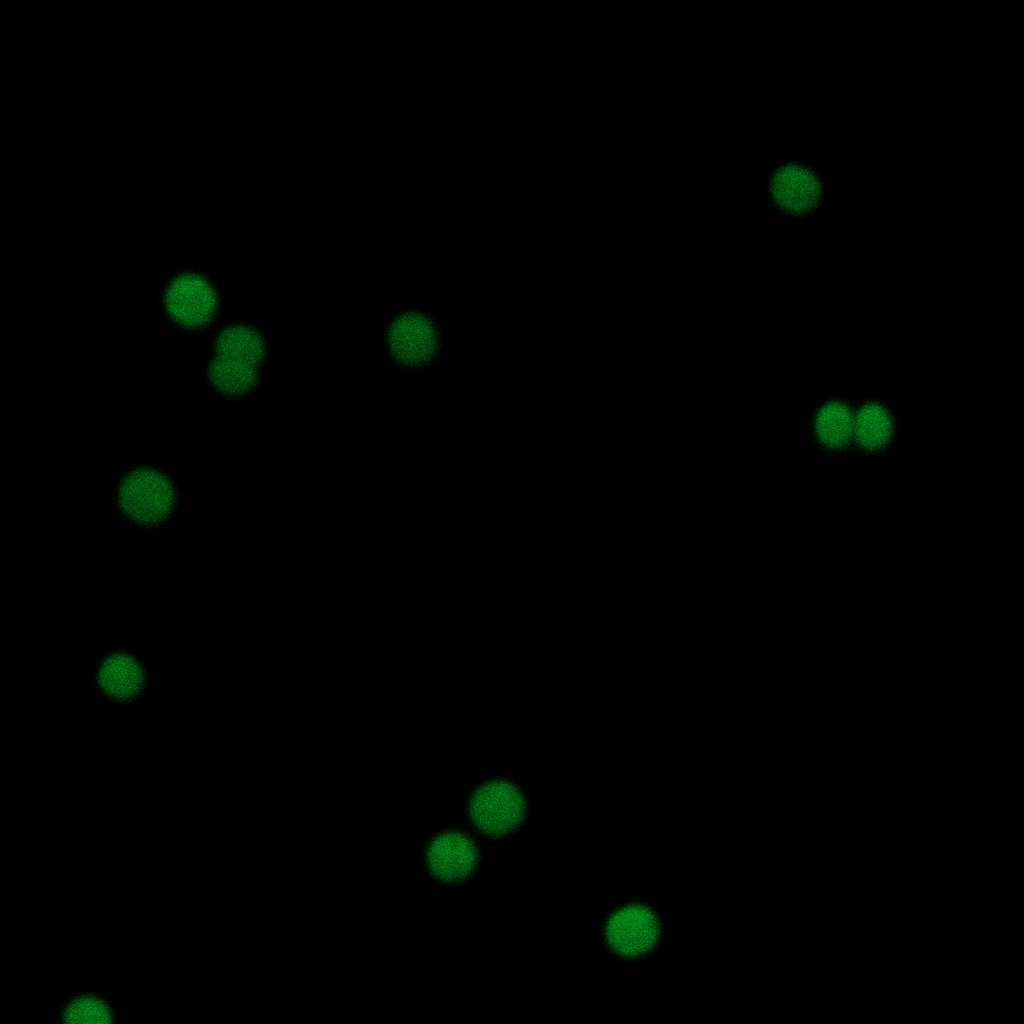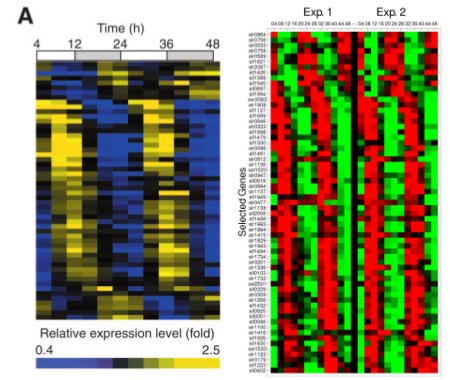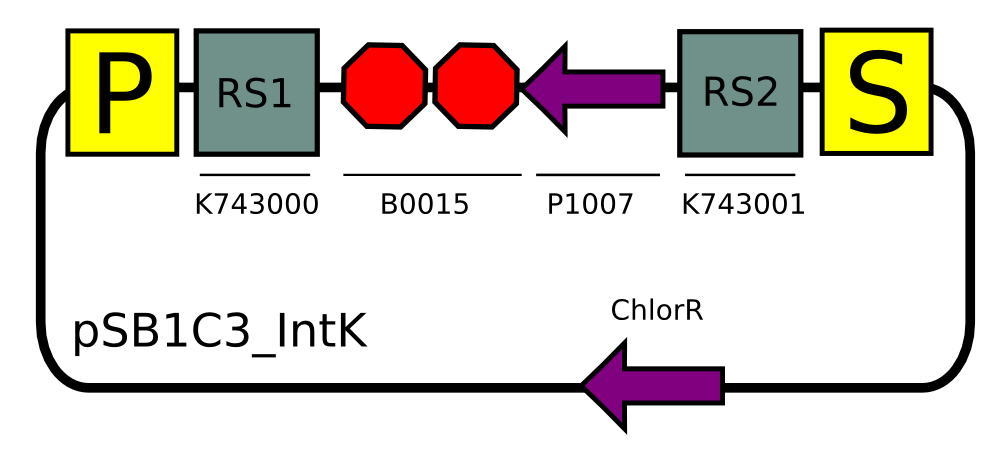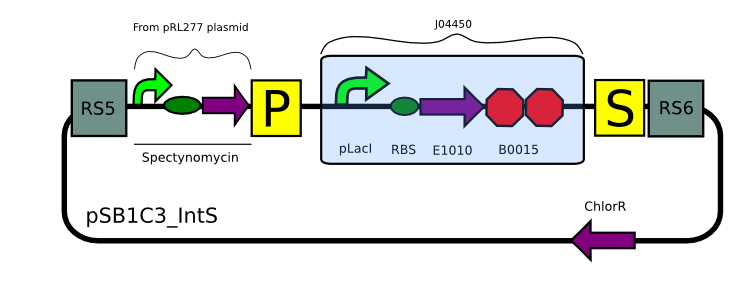Team:UC Chile/Cyanolux/Project
From 2012.igem.org
(Difference between revisions)
(Created page with "{{UC_Chile4}} <h1>Main Goal</h1> <p>Natural cycles have always fascinated mankind, probably due to the mysterious mechanisms involved in them and the power they exert in our ev...") |
|||
| (41 intermediate revisions not shown) | |||
| Line 3: | Line 3: | ||
<h1>Main Goal</h1> | <h1>Main Goal</h1> | ||
| - | <p>Natural cycles have always fascinated mankind, probably due to the mysterious mechanisms involved in them and the power they exert in our everyday life. Since the dawn of synthetic biology, engineering oscillatory systems has been a recurrent topic, being Ellowitz's | + | <p>Natural cycles have always fascinated mankind, probably due to the mysterious mechanisms involved in them and the power they exert in our everyday life. Since the dawn of synthetic biology, engineering oscillatory systems has been a recurrent topic, being Ellowitz's repressilator a classical example. Nevertheless, to date no iGEM team has accomplished the implementation of a robust oscillatory system. That will be our challenge for this year's iGEM project.</p> |
<br /> | <br /> | ||
| - | <p>To reach our goal we designed a synthethic circuit that links to the endogenous circadian rhythm of <i>Synechocystis PCC6803.</i> As a proof of concept we are going to engineer the first light-rechargeable biological lamp: <i>Synechocystis PCC 6803</i> cells that emit light only by night while recovering and producing the substrates | + | <p>To reach our goal we designed a synthethic circuit that links to the endogenous circadian rhythm of <i>Synechocystis PCC6803.</i> As a proof of concept we are going to engineer the first light-rechargeable biological lamp: <i>Synechocystis PCC 6803</i> cells that emit light only by night while recovering and producing the substrates during the day.<b> We strongly believe</b> this will serve as an enabling tool to any project requiring time control over a biological behaviour independently of the user's input.</p> |
<br /> | <br /> | ||
| Line 13: | Line 13: | ||
<h2>Synechocystis PCC 6803</h2> | <h2>Synechocystis PCC 6803</h2> | ||
| + | <!-- | ||
| + | <html><img src="https://static.igem.org/mediawiki/2012/2/2c/Synecultureex_uc_chile.jpg" width="290" align="right" style ="margin-left:15px"></html> | ||
| + | --> | ||
| + | <div id="boxright" style="width: 300px; padding-left: 15px; padding-right: 0px;"> | ||
| + | [[File:Mishtickgreenthumb.jpg| 300px | right]] | ||
| + | </div> | ||
| - | + | <p>Cyanobacteria are prokaryotic photoautotrophs and they are believed to have | |
| - | <p>Cyanobacteria are prokaryotic photoautotrophs and they are believed to | + | evolved oxygenic photosynthesis about 2.4 billion years ago [[#1|1]]. Although this biochemical breakthrough can not |
| - | + | ||
be understated, several cyanobacteria species also play a crucial role in the planet nitrogen cycle as marine | be understated, several cyanobacteria species also play a crucial role in the planet nitrogen cycle as marine | ||
diazotrophs [[#2|2]]. Cyanobacteria are found almost in every environment in earth´s surface and interestingly, they | diazotrophs [[#2|2]]. Cyanobacteria are found almost in every environment in earth´s surface and interestingly, they | ||
| Line 23: | Line 28: | ||
<br /> | <br /> | ||
<p><i>Synechocystis PCC6803</i> is a gram negative non-filamentous cyanobacteria and it was the third | <p><i>Synechocystis PCC6803</i> is a gram negative non-filamentous cyanobacteria and it was the third | ||
| - | prokaryote and the first photoautotroph whose genome was sequenced. Consequently, | + | prokaryote and the first photoautotroph whose genome was sequenced. Consequently, it has become a model organism as its genetic background has been widely studied.</p> |
<br /> | <br /> | ||
| Line 34: | Line 39: | ||
<br /> | <br /> | ||
| - | <p>While aware of these practical applications, we (UC_Chile) are | + | <p>While aware of these practical applications, we (UC_Chile) are particularly interested in the well |
characterized circadian behavior of this chassis [[#7|7]] and its implications. There are several | characterized circadian behavior of this chassis [[#7|7]] and its implications. There are several | ||
genes known to oscillate in a daily basis, most of them related to respiration, photosynthesis and energy | genes known to oscillate in a daily basis, most of them related to respiration, photosynthesis and energy | ||
| Line 41: | Line 46: | ||
<br /> | <br /> | ||
| - | <p>Lastly, there are a lot of biobricks designed especially for <i>Synechocystis</i> or from its | + | <p>Lastly, there are a lot of biobricks designed especially for <i>Synechocystis</i> or derived from its genetic information by previous iGEM teams (references). However, sadly no one has characterized them in this chassis and the registry lacks a set of tools for its transformation with standard biological parts. Moreover, to our |
| - | + | ||
| - | and the registry lacks a set of tools for its transformation with standard biological parts. Moreover, to our | + | |
knowledge, no iGEM team has ever accomplished a successful direct <i>Synechocystis</i> transformation with naked DNA.</p> | knowledge, no iGEM team has ever accomplished a successful direct <i>Synechocystis</i> transformation with naked DNA.</p> | ||
<br /> | <br /> | ||
<h2>Lux Operon </h2> | <h2>Lux Operon </h2> | ||
| + | |||
| + | <html><img src="https://static.igem.org/mediawiki/2012/5/56/Alagain_uc_chile.jpg" width="300" align="right" style ="margin-left:15px"></html> | ||
<p>The lux operon is a group of genes that are responsible for density-dependent bioluminescent behavior | <p>The lux operon is a group of genes that are responsible for density-dependent bioluminescent behavior | ||
in various prokariotic organisms such as <i>Vibrio fischeri</i> and <i>Photorabdus luminescens</i> [[#12|12]]. In <i>V. fischeri</i>, the operon is composed of 8 genes: LuxA and LuxB encode for the monomers of a heterodimeric luciferase; LuxC, LuxD and LuxE code for fatty acid reductases enzymes and LuxR and LuxI are responsible for the regulation of the whole operon [[#13|13]].</p> | in various prokariotic organisms such as <i>Vibrio fischeri</i> and <i>Photorabdus luminescens</i> [[#12|12]]. In <i>V. fischeri</i>, the operon is composed of 8 genes: LuxA and LuxB encode for the monomers of a heterodimeric luciferase; LuxC, LuxD and LuxE code for fatty acid reductases enzymes and LuxR and LuxI are responsible for the regulation of the whole operon [[#13|13]].</p> | ||
<br /> | <br /> | ||
| + | |||
<p>Lastly LuxG is believed to act as a FMNH2 dependent FADH reductase, although luminescence is barely affected | <p>Lastly LuxG is believed to act as a FMNH2 dependent FADH reductase, although luminescence is barely affected | ||
| - | in its absence [[#14|14]]. The n-decanal ( n= 9 to 14) substrate oxidization to n-decanoic acid by the LuxAB heterodimer is coupled with the reduction of FMNH to FMNH2 and the | + | in its absence [[#14|14]]. The n-decanal ( n= 9 to 14) substrate oxidization to n-decanoic acid by the LuxAB heterodimer is coupled with the reduction of FMNH to FMNH2 and the release of oxygen and light.</p> |
<br /> | <br /> | ||
<p>The carboxylic group of the product is then reduced to aldehyde by CDE proteins allowing the reaction to | <p>The carboxylic group of the product is then reduced to aldehyde by CDE proteins allowing the reaction to | ||
start over [[#15|15]].</p> | start over [[#15|15]].</p> | ||
<br /> | <br /> | ||
| - | + | ||
| - | + | ||
<p>LuxAB genes have been widely used as reporters dependent on the addition of n-decanal to the culture | <p>LuxAB genes have been widely used as reporters dependent on the addition of n-decanal to the culture | ||
media [[#16|16]] and in 2010, the [https://2010.igem.org/Team:Cambridge Cambridge iGEM team] engineered LuxABCDEG to an <i>E. coli</i>-optimized biobrick | media [[#16|16]] and in 2010, the [https://2010.igem.org/Team:Cambridge Cambridge iGEM team] engineered LuxABCDEG to an <i>E. coli</i>-optimized biobrick | ||
| Line 65: | Line 70: | ||
<br /> | <br /> | ||
| - | <p>As a team we decided to work with this operon for a number of reasons, first of all, the | + | <div style="margin-left: auto; margin-right: auto; width: 500px;"> |
| - | produced by this pathway is much | + | <html> |
| - | + | <img style ="margin-left: 0; margin-right: 0; width: 500px;" src="https://static.igem.org/mediawiki/2012/5/56/UC_Chile-Esquema_reacciones_Lux.jpg"/></html> | |
| + | </div> | ||
| + | |||
| + | <p>As a team we decided to work with this operon for a number of reasons, first of all, the bioluminescence | ||
| + | produced by this pathway is much stronger than other systems from the registry (i.e XFPs). | ||
| + | Moreover, the light production does not depend on a single peptide but on a whole pathway involving several genes, which makes it much more tunable, for instance, decoupling in time the substrate recovery from the luciferase reaction itself.</p> | ||
<br> | <br> | ||
<br> | <br> | ||
| Line 73: | Line 83: | ||
<h1>Experimental Strategy</h1> | <h1>Experimental Strategy</h1> | ||
<p>We have devised different strategies to achieve bioluminescence controlled under circadian rhythms. Here we describe the strategies used for building the constructs to reach our goals.</p> | <p>We have devised different strategies to achieve bioluminescence controlled under circadian rhythms. Here we describe the strategies used for building the constructs to reach our goals.</p> | ||
| - | |||
| - | |||
<h2>Splitting the Lux operon and choosing promoters</h2> | <h2>Splitting the Lux operon and choosing promoters</h2> | ||
| Line 83: | Line 91: | ||
<br /> | <br /> | ||
| - | + | <p>To try our approach, we selected various promoters which could serve the purpose. Our rational for selecting candidate promoters involved amplitude of oscillation, peak activity, hour, absence of restriction sites, predicted strength of promoter according to the role of the gene and reproducibility between experiments (based on the literature available). We looked for promoters which would have peak expression nearby dusk hours and that were slightly out of phase to optimize production of bioluminescence according to our [https://2012.igem.org/Team:UC_Chile/Cyanolux/Modelling mathematical models]. We prioritized promoters from genes that would be involved in central energetic metabolism as we believe that their expression would be most robust and reliable.</p> | |
| - | <p>To try our approach, we selected various promoters which could serve the purpose. Our rational for selecting candidate promoters involved amplitude of oscillation, peak activity, hour, absence of restriction sites, predicted strength of promoter according to the role of the gene and reproducibility between experiments (based on the literature available). We looked for promoters which would have peak expression nearby dusk hours and that were slightly out of phase to optimize production of bioluminescence according to our mathematical models | + | |
<br /> | <br /> | ||
| - | <p>We choose the transaldolase promoter | + | <p>We choose the transaldolase promoter to direct the expression of the LuxAB genes and we found a couple of other promoters which filled the other requirements from above. Pcaa3 and PsigE, the former being already in Biobrick format (courtesy from the Utah team iGEM 2010). |
</p> | </p> | ||
| Line 99: | Line 106: | ||
<h3>pSB1C3_IntK</h3> [http://partsregistry.org/Part:BBa_K743006 BBa_K743006] | <h3>pSB1C3_IntK</h3> [http://partsregistry.org/Part:BBa_K743006 BBa_K743006] | ||
| - | <p>This construct is an integrative plasmid which targets neutral recombination sites (slr0370 and sll0337). We selected this locus because it has been extensively used in the literature ([[#11| 11]]) and it shown to have no deleterious effects on Synechocystis viability. We selected Kanamycin resistance as our selectable marker. | + | <br> |
| + | <div id="boxright" style="width:500px;"> | ||
| + | [[File:UC_Chile-IntKplasmidResult.jpg | 500px | right]] | ||
| + | </div> | ||
| + | <p>This construct is an integrative plasmid which targets neutral recombination sites (slr0370 and sll0337). We selected this locus because it has been extensively used in the literature ([[#11| 11]]) and it shown to have no deleterious effects on Synechocystis viability. We selected Kanamycin resistance as our selectable marker. | ||
<br> | <br> | ||
Using this backbone we have decided to put LuxAB under the transaldolase promoter.We have choose the transaldolase promoter to express the luciferase part of the operon, as in the literature the promoter is described as having a peak of expression at 2 hours past dusk, which we believe is just the right timing to "turn on the lamp". | Using this backbone we have decided to put LuxAB under the transaldolase promoter.We have choose the transaldolase promoter to express the luciferase part of the operon, as in the literature the promoter is described as having a peak of expression at 2 hours past dusk, which we believe is just the right timing to "turn on the lamp". | ||
| Line 108: | Line 119: | ||
<h3>pSB1A3_IntC (Utah 2010 iGEM Team integration plasmid)</h3> | <h3>pSB1A3_IntC (Utah 2010 iGEM Team integration plasmid)</h3> | ||
<br /> | <br /> | ||
| - | + | We plan on using this plasmid to express the LuxCDEG contructs under the regulation of the Pcaa3 and PsigE promoters mentioned above. [http://partsregistry.org/wiki/index.php?title=Part:BBa_K390200 pSB1A3_IntC]. | |
<h3>pSB1C3_IntS</h3> | <h3>pSB1C3_IntS</h3> | ||
| + | |||
<br /> | <br /> | ||
| - | <p>Due to issues mentioned in the results page | + | <div id="boxright" style="width:500px;"> |
| - | This is an integration plasmid which makes Synechocystis susceptible to copper concentrations higher than 0.75 uM [[#10|10]] by disrupting the CopS gene. We believe that this strategy serves as a biosafety measure to avoid the possibility of having a leakage of recombinant DNA to the environment. The plasmid uses Spectynomycin as a selectable marker. | + | [[File:UC_Chile-IntSplasmidResult.jpg | 500px | right]] |
| + | </div> | ||
| + | |||
| + | <p>Due to issues mentioned in the [https://2012.igem.org/Team:UC_Chile/Cyanolux/Results results page] we designed a new plasmid backbone. | ||
| + | This is an integration plasmid which makes Synechocystis susceptible to copper concentrations higher than 0.75 uM [[#10|10]] by disrupting the CopS gene. We believe that this strategy serves as a biosafety measure to avoid the possibility of having a leakage of recombinant DNA to the environment. The [http://partsregistry.org/Part:BBa_K743010 plasmid] uses Spectynomycin as a selectable marker. | ||
</p> | </p> | ||
| - | We plan on expressing LuxCDEG under the control of the promoters Pcaa3 and PsigE (mentioned above). These promoters have peak activities 1 hour before dusk. | + | We plan on expressing LuxCDEG under the control of the promoters Pcaa3 and PsigE (mentioned above). These promoters have peak activities 1 hour before dusk. Based on our [https://2012.igem.org/Team:UC_Chile/Cyanolux/Modelling modelling] we believe that we might enhance bioluminescence yield initially by setting the substrate production/regeneration part of the operon prior to the expression of the luciferase. |
| + | |||
| + | |||
| + | <h2>Implementation</h2> | ||
| + | |||
| + | Synthetic biology is inspired in nature to make abstractions of its principles and mechanisms. We thought this moto could be applied beyond mollecular genetics... | ||
| + | |||
| + | With the relevance of context in mind, a biomimetic biolamp structure was designed that resembles the organ in which Vibrio fischeri -the bacteria from which the lux genes were biobricked- lives. | ||
| + | <html><center><img src="https://static.igem.org/mediawiki/2012/b/b3/Biomimetic.jpg" align="middle" width="860"></center></html> | ||
| + | |||
| + | |||
| + | [https://2012.igem.org/Team:UC_Chile/Cyanolux/Biolamp Full description of the device here] | ||
| + | |||
| + | <html> | ||
| + | <a href="https://2012.igem.org/Team:UC_Chile/Cyanolux/Results"><img src="https://static.igem.org/mediawiki/2012/a/ab/UC_Chile-Continue_button.jpg" align="right"> | ||
| + | </html> | ||
| + | |||
<h1>References</h1> | <h1>References</h1> | ||
| Line 190: | Line 222: | ||
<div id="16"> | <div id="16"> | ||
(16)Tehrani, G. A., Mirzaahmadi, S., Bandehpour, M., & Laloei, F. (2011). Molecular cloning and expression of the luciferase coding genes of Vibrio fischeri. Journal of Biotechnology, 10(20), 4018-4023. doi:10.5897/AJB10.2363 | (16)Tehrani, G. A., Mirzaahmadi, S., Bandehpour, M., & Laloei, F. (2011). Molecular cloning and expression of the luciferase coding genes of Vibrio fischeri. Journal of Biotechnology, 10(20), 4018-4023. doi:10.5897/AJB10.2363 | ||
| + | |||
| + | |||
{{UC_Chilefooter}} | {{UC_Chilefooter}} | ||
Latest revision as of 12:26, 26 October 2012
 "
"














